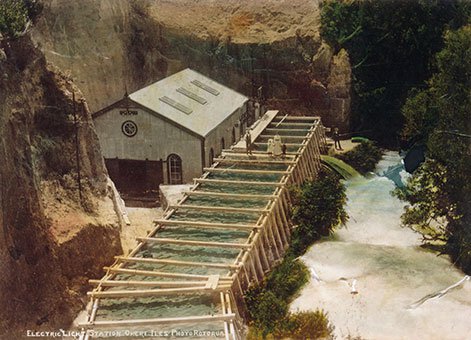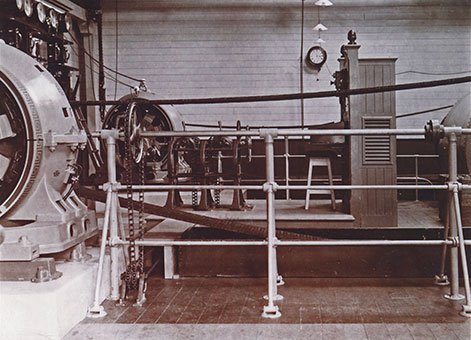Constructed between 1899 and 1901, the Ōkere Falls Power Station on the Kaituna River was the New Zealand central government’s first hydro-electric power scheme. The station was initially built to power sewerage pumps and lighting in Rotorua, a significant tourism town.
Planning to power Rotorua
The first public lighting system for the township of Rotorua came into use during October 1897 when a number of street lamps were erected. This lighting, although on a modest scale, was welcomed by residents, but much better things were in store.
Although electricity was not widely available in New Zealand in the late 19th century, the Lake House Hotel had been considering it. By this time Rotorua was well-established as a prime New Zealand tourist destination, so much so that in 1901 the Department of Tourism and Health Resorts took over administration of the town.
Investigations into a hydroelectric scheme began during 1897 and a decision was made to locate it at Ōkere Falls. The possibilities of the scheme contemplated by the government were evident as these falls had for some time been considered an excellent source of cheaply secured and easily transmitted energy.
The first hurdle was securing the land beside the river which had importance for local Maori and the area in general had historical significance. Objections to the acquisition of the land were anticipated, but tactful negotiations by respected local people proved successful. Once the site was secured the hydro-electric power scheme progressed rapidly.

Ōkere Falls Power Station, circa 1901. Image courtesy of R. Aspden.
Power from Ōkere Falls
The tender for the electric generating plant was let in October 1899, together with the provision of a pumping plant at the Rotorua sewerage works and the supply of arc and incandescent lamps in the township. During August 1900, tenders were called for the dynamo building (£526) on the river’s edge and a house (£400) for the operator. The scheduled completion date was to be July 1900 but it was not until May 1901 that the scheme came into operation.
Just in time for the Duke and Duchess of York’s royal visit in May 1901 the railway station, post office, public baths, and the sanatorium grounds were lit by electricity for the first time, as was the Geyser Hotel in Whakarewarewa. The light cast by the new system was in sharp contrast to the “one candlepower” lamps previously in use at the station and one report said that even the approaching locomotive light paled into insignificance by comparison. There was good reason for enthusiasm in Rotorua, as there were only three other communities in New Zealand enjoying public electricity at that time – Reefton, Wellington and Stratford.
The supply of electricity to Rotorua was almost as big an attraction for some visitors as its more celebrated tourist attractions. Advertising made much of this new power source and as the people of Rotorua were conscious of the part visitors played in its economics they made efforts to publicise their electric power.

Ōkere Falls Power Station interior, circa 1905. Image courtesy of R. Aspden.
Supply and demand problems
It was soon wondered why only two 50 kilowatt (kW) generators were installed because within a year demand had exceeded all expectation. The reason for this seems to have been inadequate preliminary research about prospective residential requirements.
The following year the Palace and Grand Hotels were connected and the daily average load was increased by the equivalent of one generator. Rotorua’s government engineer, Lawrence Birks, urged the Tourism Department to consider an additional generator because he was certain the station would be at full capacity by the end of 1903. The request was refused despite two extra motors for pumping sewage being added to the load. The power station’s plant ran continuously from dawn to midnight, with the remaining hours of the day reserved for maintenance.
By 1907 the strain on the plant led to plans for additions designed to double the output. Eventually a wing dam was completed in 1908, costing £320. The power station extensions resulted in more connections and, for the first time in the country, floodlights were provided for a major bowling tournament. Rotorua’s famous Bath House was also completed in 1908, and naturally it was electrically lit and heated so an oil generating set was installed at Ōkere Falls to relieve the loading.
The death knell for the scheme began sounding during the 1920s though with the arrival of electric power from the Horahora and Arapuni Power Stations on the Waikato River, in 1926 and 1930 respectively. Previously, there had been proposals that the generating power at Ōkere Falls should be increased to meet higher demands. However, by 1924 the Arapuni scheme had been decided upon and there was no doubt it would eventually supply adequate power.
However, initially the Arapuni scheme experienced problems requiring it to be temporarily shut down, causing concern in Rotorua, which had been persuaded to rely upon it. In June 1930 action had to be taken to recondition the run-down Ōkere Falls scheme. Once this had been done the Tourist Department then arranged to run the Ōkere plant for 16 hours a day and the diesel plant for 6 hours a day. This kept the district supplied during the Arapuni problems.
Ōkere Falls Power Station closes
Despite being useful during the Arapuni scheme’s teething issues, the 1930s saw the end of the Ōkere Falls Power Station because it was no longer considered of value. In July 1939 it was announced that from 30 September the station would be closed. The power station seems to have been dismantled in the early 1940s.
The site is now part of the Department of Conservation’s (DOC) Ōkere Falls Scenic Reserve. DOC has installed interpretation about the former power station’s site and in 1995 one of the riverbank turbines was preserved and placed beside the track. The steps which previously lead to the power station now provide access to an Ōkere Falls viewing platform.
More information
Access
Trout Pool Road continues on from Ōkere Falls Road which is accessed by turning north off of State Highway 33 at Ōkere Falls. The Ōkere Falls Scenic Reserve is approximately 21 kilometres from Rotorua.
The Department of Conservation website provides further access information.
Further reading
John Martin, People, Politics and Power Stations: Electricity generation in New Zealand, 1880–1998 (Wellington: Electricity Corporation of New Zealand, 1998).
Neil Rennie, Power to the People: 100 years of public electricity supply in New Zealand (Wellington: Electricity Supply Association of New Zealand, 1989).
Location
Ōkere Falls Scenic Reserve, Trout Pool Road, Ōkere Falls.
